Serviços Personalizados
Journal
Artigo
Indicadores
-
 Citado por SciELO
Citado por SciELO -
 Acessos
Acessos
Links relacionados
-
 Citado por Google
Citado por Google -
 Similares em
SciELO
Similares em
SciELO -
 Similares em Google
Similares em Google
Compartilhar
Ingeniería e Investigación
versão impressa ISSN 0120-5609
Ing. Investig. vol.34 no.2 Bogotá maio/ago. 2014
https://doi.org/10.15446/ing.investig.v34n2.40504
http://dx.doi.org/10.15446/ing.investig.v34n2.40504
J. M. Villegas1 and H. Avila2
1 Jorge M. Villegas. Ingeniero Químico, Universidad del Atlántico, Colombia. Affila-tion: M. Sc. Student at Instituto de Estudios Hidráulicos y Ambientales, Universidad del Norte, Colombia. Email: jvillegasm@uninorte.edu.co
2 Humberto Ávila. PhD. Civil Eng, MSc. Applied Statistics, University of Alabama, USA. MSc. Ing. Civil, Universidad de los Andes, Colombia, Ingeniero Civil, Universidad del Norte, Colombia. Affiliation: Profesor Asistente Departamento de Ingeniería Civil y Ambiental, Instituto de Estudios Hidráulicos y Ambientales, Universidad del Norte, Colombia. Email: havila@uninorte.edu.co
How to cite: Villegas, J. M., & Ávila, H. (2014). Quick-scan estimating model of higher heating value of oil palm empty fruit bunches based on ash from proximate analysis data. Ingeniería e Investigación, 34(2), 33-38.
ABSTRACT
A correlation model developed for the quick-scan estimation of the Higher Heating Value (HHV) based on the ash content from a proximate analysis of Oil Palm Empty Fruit Bunches (EFB) is presented in this paper. The correlation was developed using a best subsets regression method with data of biomass samples. EFB were taken directly from the end of the processing line (the process exit after the fruit removal section) in agro-industrial palm oil extraction facilities that are located on the Colombian coast. The correlation is also compared with other published correlations of lignocellulosic biomass. After conducting a statistical analysis from proximate analysis variables expressed in the dry basis for Fixed Carbon (FC), Ash content (Ash), and Volatile Matter (VM), colinearity was identified between Ash - VM - FC, VM - FC, in developed models that show unsatisfactory behavior when these variables are included, indicating that these models are inadequate. Finally, the correlation model for a quick-scan estimation on the dry basis was obtained based on the Ash content from a proximate analysis of EFB (HHV= 0.827Ash + C, with C between 9.97 and 12.4), with a mean absolute error (MEA) lower than 3% and a marginal mean bias error (MBE) of 0.19%, and R2 = 0.8, indicating that the model has an HHV with single input variable predictive capability. This model can be used as a support tool for quick-scan estimation when evaluating the available bioenergy in the processing of EFB using economical and efficient energetic indicators. The minimum and maximum values of HHV obtained for EFB were 13.6 and 21.91 MJ/kg, respectively.
Keywords: Oil Palm Empty Fruit Bunch (EFB), Higher Heating Value, Proximate analysis, Lignocellulosic Biomass, Biofuel energy.
RESUMEN
Un modelo de correlación desarrollado para la estimación rápida del Poder Calorífico Superior (HHV) de racimos vacíos del fruto de palma de aceite (EFB) basado en el contenido de cenizas obtenido a partir de datos de análisis próximo es presentado en este artículo. La correlación se desarrolló a través del método de regresión de mejores subconjuntos mediante el uso de datos de muestras obtenidas directamente de la línea de procesamiento (la salida del proceso después de la sección de desfrutado) en instalaciones de empresas agro-industriales extractoras de aceite de palma ubicadas en la costa colombiana. La correlación obtenida se comparó con otros modelos publicados para estimar HHV para biomasa lignocelulósica. Luego de un análisis estadístico a las variables de análisis próximo expresadas en base seca Carbono Fijo (FC), Contenido de cenizas (Ash), Material Volátil (MV), se evidenció co-linearidad en los modelos desarrollados entre Ash - VM - FC, VM - FC, mostrando comportamientos insatisfactorios cuando se incluyen estas variables indicando modelos inadecuados. Finalmente el modelo de correlación para estimación rápida en base seca se obtuvo a partir del contenido de cenizas del EFB de datos de análisis próximo (HHV= 0.827Ash + C, con C entre 9.97 y 12.4) presentado un error absoluto medio (MEA) menor al 3%, error marginal medio (MBE) de 0.19% y un R2 = 0.8, indicando capacidad predictiva para el HHV con una variable de entrada, el cual puede ser utilizado como herramienta soporte para la estimación rápida del indicador energético en la evaluación de bioenergía disponible en procesos de tratamientos para el EFB de manera económica y eficiente. El HHV mínimo y máximo obtenido para EFB fue de 13.6 y 19.51 MJ/kg, respectivamente.
Palabras clave: Racimo vacío del fruto de palma de aceite (EFB), Poder Calorífico Superior (HHV), Análisis próximo, Biomasa lignocelulósica, Bioenergía.
Received: December 30th 2013 Accepted: March 10th 2014
Introduction
According to the International Energy Agency (IEA, 2008), the use of renewable energy is estimated to contribute on the order of 10-14% to the primary world energy demand. The most important source of increasing the production of energy based on renewable energy sources is the biomass. In accordance with (Erol, Haykiri-Acma & Küçükbayrak, 2011), the limitations of carbon-based fuels as the main supply source of energy consumption have motivated scientists, politicians, and economists to think of alternatives with lower potential impacts on environmental and economic development. (Aslani & Mohaghar, 2013) indicated that carbon-based fuels are neither harvestable in all countries nor sustainable in producer countries. In Colombia specifically, Palm Oil (Elaeis guineensis) Empty Fruit Bunches (EFB) represent a lignocellulosic biomass generated during the oil extraction process that can be used as raw material for cellulose, lignin and hemicellulose production (Soplah et al., 2009; Gonzalez et al., 2009).
EFB is a material that has great agro-industrial availability in the present and future in Colombia and other sites around the world. In sites where crops of this material can be found, huge quantities of these residues are generated; generally, the EFB is burned or incinerated in facilities (Gonzalez et al., 2009; Ministry of Mining and Energy, (Minminas, 2009); Shuit, Tan, Lee, & Kamaruddin, 2009). The primary solid wastes of palm oil mill processing are EFB, fibers and shells (Rozita et al., 2011). However, the concerns of (Mohamad, Zakaria & Sipaut, 2011) about the effects of this lignocellulosic waste on human and natural environments have prompted recycling initiatives. Thus, the waste is used for energy diversification process such as ethanol production (Piarpuzán, Quintero & Cardona, 2011), pyrolysis processes (Abdullah & Gerhauser, 2008; Chin & Bakar, 2009; Sukiran, Abdullah, Gerhauser & Sulaiman, 2010; Rozita et al., 2011; Sulaiman & Abdullah, 2011; Wu et al., 2013; Burhennea et al., 2013), gasification processes (Lahijani & Alimuddin, 2011; Mohammed, Salmiaton, Wan, & Mohamad, 2012; Ogi et al., 2013) and applied technology to produce heat and power.
This study has been conducted due to the need to evaluate and develop a simple tool for estimating the caloric value of EFB, which is one of the main biomass agro-industrial resources in the country. According to (Vargas-Moreno et al., 2012), the higher heating value (HHV), which refers to the heat released by the complete combustion of a unit of volume of fuel (Chun-Yang, 2011), is an indicator that a raw material can be used as an energy supply and reflects the energy content of a fuel in a standardized fashion. Other studies and experimental correlations have been used to determine the HHV of biomass by proximate analysis, but the value can differ significantly among analyses (Erol et al., 2010; Chun-Yang, 2011; Vargas-Moreno et al., 2012). In some cases, a representative approximate value of the fluctuations in multiple biomasses is not available because of the varying characteristics of raw materials and even greater differences among biomasses (Erol et al., 2010; Nhuchhen & Salam, 2012). The variables evaluated in the proximate analyses have been used in multiple models to estimate the HHV of biomass and lignocellulosic materials, as reported by different authors (Chun-Yang, 2011; Vargas-Moreno et al., 2012). However, in some cases, the models do not properly fit the measured value for the HHV (Nhuchhen & Salam, 2012). For this reason, we propose a quick solution as a simple tool for estimating the Higher Heating Value (HHV, MJ/kg) from the experimental analysis of EFB. This method allows for correlation of the HHV with experimental variables that can be measured simply, both economically and technically, in a lab, due to the ease and speed with which such an analysis can be accomplished.
Material and methods
Samples were selected in the field using a simple, random sampling via the point-quarter method. The samples were taken directly from the end of the processing line (the process exit after the fruit removal section) in three facilities of agro-industrial companies located in the Departments of Magdalena, Bolívar, and Cesar (Colombia). From each facility, 30 empty fruit bunches were collected. Sample preparation was performed according to the methodology described in the ASTM E1517-01 standard in the following phases: selection, measurement, conditioning, size reduction, and sample homogenization. Subsequently, all samples were mixed, homogenized and prepared for testing and analysis. Figure 1 shows the EFB at the laboratory. The tests were conducted at three laboratories in Colombia: the Colombian Geological Services (Ingeominas), the Centro de Estudios e Investigación en Biotecnología (CIBIOT) of the Universidad Pontificia Bolivariana (Medellín), and the Universidad del Norte (Barranquilla). The Higher Heating Value tests were conducted at Ingeominas and CIBIOT. The American Society for Testing and Materials (ASTM) international standards were used for the analysis, according to the procedures and protocols for wood and biomass (lignocellulosic matter), as well as those used for carbon and coke. Cellulose, hemicellulose, and lignin contents were performed through HPLC analysis according to the NREL-TP510-42618 (2008) rules. Table 1 describes the norms used for the samples.
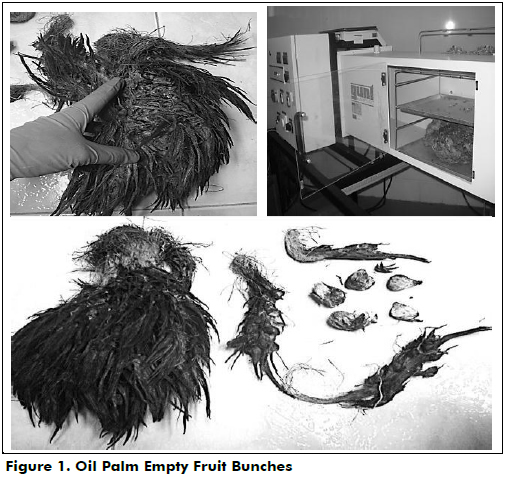
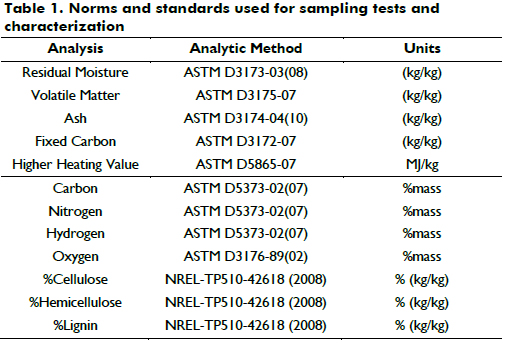
Data analysis and characterization
Proximate analysis is the most commonly used method for characterizing biomass fuels. Consequently, it is important to have a model that approximates a fit of Higher Heating Value to the Proximate Analysis experimental data. A correlation model to estimate the Higher Heating Value (HHV, MJ/kg) was evaluated based on 7 samples of EFB characterized using a complete Proximate Analysis expressed in terms of the composition in the mass fraction (kg/kg) dry basis of Fixed Carbon (FC), Ash Content (Ash), Volatile Matter (VM), and Residual Moisture.
Results
Analysis and selection of variables
The complete proximate analysis results of the collected samples, including the HHV (MJ/kg) and elemental and structural analyses, are shown in Table 2. Ash, Volatile Matter, and Fixed Carbon had average dry basis mass fractions (kg/kg) of 0.069, 0.753, and 0.178, respectively. The average HHV obtained was 15.7 (MJ/kg), and the minimum and maximum values of HHV were 14.5 (MJ/kg) and 18.0 (MJ/kg), respectively.
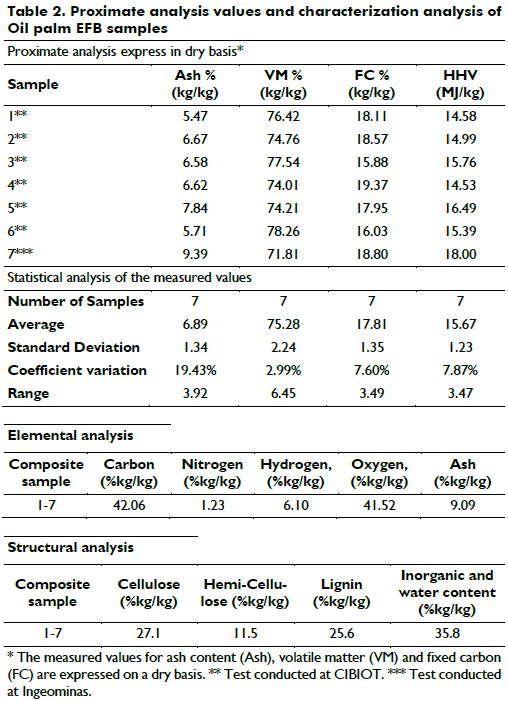
Initially, an exploratory data analysis was conducted to identify trends (Figure 2) and autocorrelations (Table 3), allowing for the selection of proximate analysis variables that significantly contributed to the model. According to Table 3, the Ash content is highly correlated to the HHV of Oil Palm EFB, and a strong linear relationship was found between the Ash content and the HHV, underlining the existence of direct proportionality between these characteristics. The correlation coefficient was 0.897 with a p-value of 0.006, indicating statistical significance.
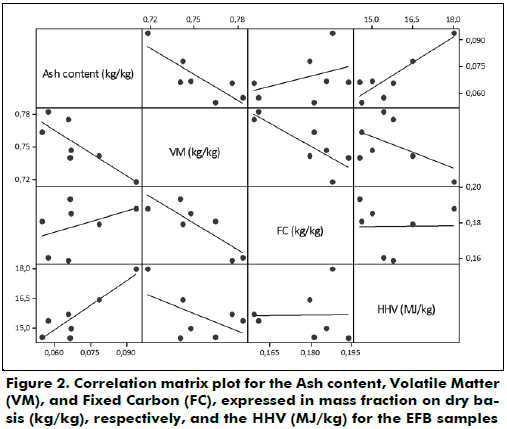
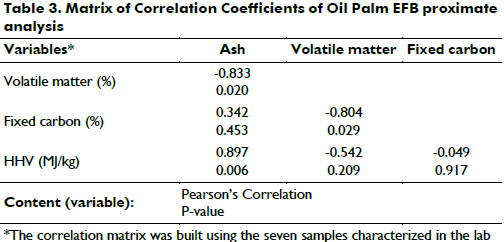
From the statistical results, the VM variable and the HHV show a Pearson correlation value of -0.542 and a p-value of 0.209. These values indicated that the volatile matter does not show statistical significance with relation to the HHV. According to the values in Table 3, the FC variable was not found to be statistically significant relative to the HHV for the population samples used in the analysis. The p-value was 0.917 and the Pearson correlation was -0.049 between this variable and the HHV.
However, for the range of samples subjected to this analysis, the results showed that Ash is inversely proportional to VM. The Pearson correlation was -0.833, with a p-value of 0.020 at a confidence level of 95%, indicating statistical significance between these variable. In contrast, no significant linear relationship was observed between Ash and FC, with a Pearson coefficient of 0.342 and a p-value of 0.453.
For the VM and FC variables, a strong linear relationship was observed because the FC in the biomass increases as the VM decreases (colinearity). The Pearson linear correlation coefficient was -0.804, and the p-value was 0.029, which indicates statistical significance between these variables.
Colinearity was identified between Ash and VM and between VM and FC due to the variance inflation factor was unsatisfactory, indicating inadequate behavior when these variables are included in different models.
According to the results in Table 3, the HHV is highly influenced by the Ash content in EFB, though the Ash content does not contribute to heat release in the biomass combustion or, hence, to the HHV. The statistical analysis showed that the Ash content was able to explain the HHV value for the Oil Palm EFB. A relationship between the ash content and the HHV was found, which explains the variability in energetic content from different materials and could be attributed to the maturity of the bunches. According to the experiments and analyses, the material with greater ash content was stronger and more robust in appearance.
HHV correlation model
A simple linear regression model, based on the values reported by the CIBIOT and Ingeominas, was determined to estimate the HHV as a function of the Ash content based on the proximate analysis on dry basis. The resulting correlation (Model 1) is as follows:

where
HHV = Higher Heating Value on dry basis (MJ/kg)
Ash = Ash content on dry basis (% kg/kg)
Figure 3 shows the regression model of Oil Palm EFB.
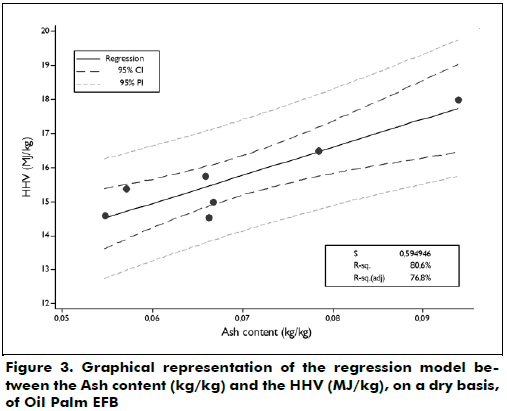
The residual analysis of the linear regression model was satisfactory for the normality and heteroscedasticity criteria using the statistical analysis software Minitab v.15. According to the ANOVA results, R2 = 0.806, and the p-value = 0.006 for the linear regression model (Table 4).
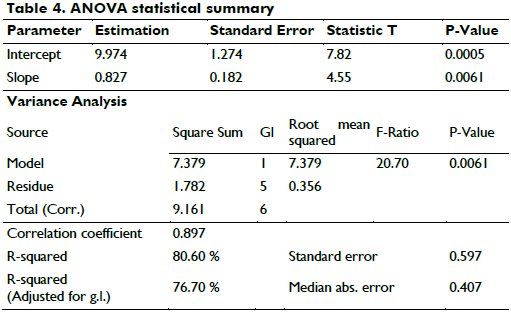
The correlation model described with a 95% confidence level, with the HHV values for confidence and prediction intervals between 13.5 - 19 MJ/kg and 12.5 - 19.5 MJ/kg, respectively.
To validate the model, EFB data were collected from studies in the literature (Table 5) with similar characteristics and structural material to the EFB samples analyses. A significant difference was found among the Ash, VM, and FC values obtained from the CIBIOT-Ingeominas data and the data obtained from the literature. However, a significant difference in the 95% confidence interval was found for the HHV from the CIBIOT-Ingeominas data and the data obtained from the literature. The results showed that the behavior of the HHV estimated by the model is similar to the values reported in the literature; however, there is a systematic difference of approximately 2.43 MJ/kg higher than the data reported by CIBIOT and Ingeominas.
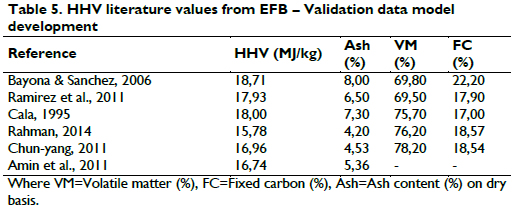
An alternative model, proposed to represents the data collected from the literature, is given by Model 2:

The model gives an R2 = 0.82 relative to the data obtained from the literature. Figure 4 shows the regression models for the measured data obtained from the laboratory (CIBIOT and INGEOMINAS) and the data obtained from the literature for the Oil Palm EFB. The linear models have the same slope, but the constant differs by approximately 2.43 MJ/kg, equivalent to a difference of approximately 16%.
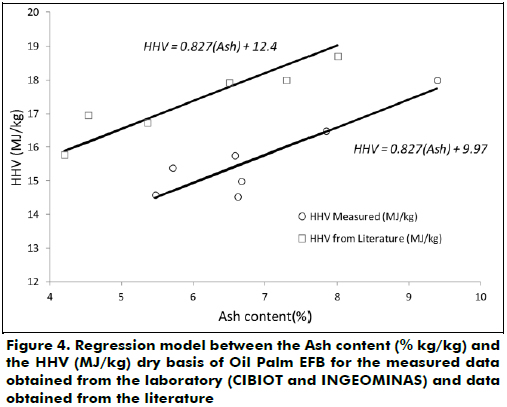
Discussion
The proposed simple linear regression models were compared with other proximate analysis-based correlation models for the HHV by different authors. The principal characteristic of this model is that it employs the lignocellulosic materials biomass to develop the models (Demirbas, 2009; Erol et al., 2010; Chun-Yang, 2011; Callejón-Ferre et al., 2011) cited in (Vargas-Moreno et al., 2012). The comparison is shown in Figure 5, and the models are presented in Table 6. In accordance with (Nhuchhen & Salam, 2012), the proximate analysis provides empirical information on the composition of the biomass, so some of the correlations based on proximate analysis may be low. Additionally, the evidence offered by the literature indicates that few researchers have centered their studies on particular types of biomass, preferring to focus on models of more general use.
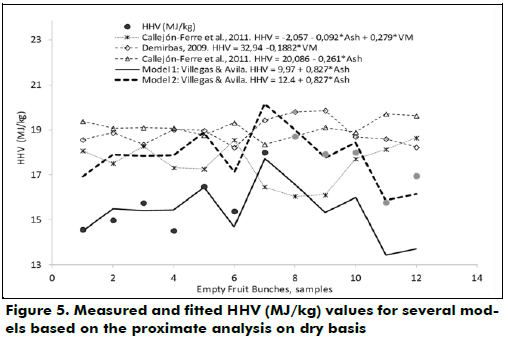
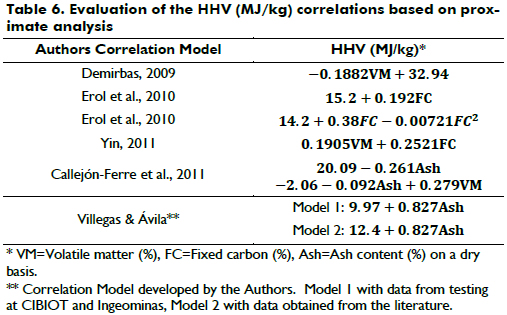
Based on the proposed correlation models, a range of HHVs between 13.6 and 21.91 MJ/kg was estimated from the proximate analysis conducted on 45 samples of EFB at the Universidad del Norte. The reported values by CIBIOT and Ingeominas showed a systematic difference of 16% lower compared with the data obtained from the literature. This difference needs to be further analyzed to identify its causes, including conducting tests with replicates in different laboratories.
Conclusion and observations
A correlation model was proposed as a quick-scan-estimate of the HHV of Oil Palm EFB from the statistical evaluation of the proximate analysis data, relating HHV with Ash content on dry basis, (HHV= 0.827Ash + C, with C between 9.97 and 12.4) with a predictive capability of R2 = 0.8. This quick model is an important tool due to the great ease with which the value variable can be determined in the lab.
The results indicate that biomass combustion with a higher HHV leads to more residue or ash from combustion. Therefore, the Ash content of the Oil Palm EFB can be used as a quick indicator of the energy content, and the experimental correlation model can be used as a simple tool for measuring the quality energy that can be supplied by processing of the raw material. The HHVs of the analyzed Oil Palm EFB were between 13.61 MJ/kg and 21.91 MJ/kg; these values are within the ranges cited in the literature for this lignocellulosic material.
The reported values by the CIBIOT and Ingeominas showed a systematic difference of 16% lower compared with the data obtained from the literature. The causes of this difference require further analysis to be identified, including conducting tests with replicates in different laboratories.
Finally, the waste of the oil palm rachis or EFB can be considered a suitable energetic resource in Colombia because of the caloric supply that can be obtained per unit mass. The value found for the HHV is in the upper range for materials with similar characteristics and for biomass of lignocellulosic origin. For this reason, EFB can be exploited as a resource of bioenergy and other derivative products, when faced with sustainability guidelines and policies. This application is in accordance with the protocols of environmental management and proper handling of solid waste, as well as the integral solution of problems that generate added value to the production chain and processes, with special interest to those related to the energy sector and the agro industry.
References
Abdul, A., Abdullah, N., & Sulaiman, F. (2014). Temperature effect on the characterization of pyrolysis products from oil palm fronds. Advances in Energy Engineering (AEE), 2, 1. [ Links ]
Abdullah, N., & Gerhauser, H. (2008). Bio-oil derived from empty fruit bunches. Fuel, 87, 2606-2613. [ Links ]
Abdullah, N., Gerhauser, H., & Sulaiman, F. (2010). Fast pyrolysis of empty fruit bunches. Fuel, 89, 2166-2169. [ Links ]
Abdullah, N., Sulaiman, F., & Gerhauser, H. (2011). Characterisation of oil palm empty bunches for fuel application. Journal of physical science, 22, 1-24. [ Links ]
Amin, N., Yaáini, N., Misson, M., Haron, R., Fadhzir, M., & Kamaroddin, A. (2011). Pre-treatment of empty fruit bunch for biofuel production. Journal of energy & Environmental, 1, 18-22. [ Links ]
Aslani, A., & Mohaghar, A. (2013). Business structure in renewable energy industry: Key areas. Renewable and Sustainable Energy Reviews, 27, 569-575. [ Links ]
Bayona, O., & Sánchez, M. (2006). Physical activation of oil palm empty fruit bunches (elais guineensis) from obtained activated carbon. Thesis for obtained degree of Chemistry. Science faculty. Industrial Santander University. [ Links ]
Burhennea, L., Messmera, J., Aichera, T., & Laborieb, M. (2013). The effect of the biomass components lignin, cellulose and hemicellulose on TGA and fixed bed pyrolysis. Journal of Analytical and Applied Pyrolysis, 101, 177-184. [ Links ]
Cala, G. (1995). Empty fruit bunches. Energy efficiency improved of extraction and production. Palmas, 16, 121. [ Links ]
Callejón-Ferre, A., Velázquez-Martí, B., López-Martínez, J., & Manzano-Agügliaro, F. (2011). Greenhouse crop residues: energy potential and models for the prediction of their higher heating value. Renew Sust. Energy Rev, 15, 948-55. [ Links ]
Chun-Yang, Y. (2011). Prediction of higher heating values of biomass from proximate and ultimate analyses. Fuel, 90, 1128-1132. [ Links ]
Demirbas, A. (2009). Prediction of higher heating values for vegetable oils and animal fats from proximate analysis data. Energy Source A, 31, 1264-1270. [ Links ]
Erol, M., Haykiri-Acma, H., & Küçükbayrak, S. (2010). Calorific value estimation of biomass from their proximate analyses data. Renewable Energy, 35, 170-173. [ Links ]
González, M., Tejado, A., Blanco, M., Mondragon, I., & Labidi, J. (2009). Agricultural palm oil tree residues as raw material for cellulose, lignin and hemicelluloses production by ethylene glycol pulping process. Chemical Engineering Journal, 148, 106-114. [ Links ]
International Energy Agency (2008). Energy Technology Perspectives 2008, in support G8 plan of action, Scenarios & Strategies to 2050. Paris, France. [ Links ]
Lahijani, P., & Alimuddin, Z. (2011). Gasification of palm empty fruit bunch in a bubbling fluidized bed: A performance and agglomeration study. Bioresource Technology, 102, 2068-2076. [ Links ]
Ministerio de Minas y Energía. MINIMINAS (2009). Atlas del Potencial Energético de la Biomasa Residual en Colombia. [ Links ]
Mohamad, M., Zakaria, N., & Sipaut, C. (2011). Chemical and thermical properties of lignins from oil palm biomass as a substitute for phenol in a phenol formaldehyde resin production. Carbohidrate Polymers, 86, 112-119. [ Links ]
Mohammed, A., Salmiaton, A., Wan, W., & Mohamad, M. (2012). Gasification of oil palm empty fruit bunches: A characterization and kinetic study. Bioresource Technology, 16, 628-636. [ Links ]
Nhuchhen, D., & Salam, P. (2012). Estimation of higher heating value of biomass from proximate analysis: A new approach. Fuel, 99, 55-63. [ Links ]
Ogi, T., Nakanishi, M., Fukuda, Y., & Matsumoto, K. (2013). Gasification of oil palm residues (empty fruit bunch) in an entrained-flow gasifier. Fuel, 104, 28-35. [ Links ]
Piarpuzán, D., Quintero, J., & Cardona, C. (2011). Empty fruit bunches from oil palm as a potential raw material for fuel ethanol production. Biomass and Bioenergy, 35, 1130-1137. [ Links ]
Ramírez, N., Silva, A., Garzón, E., & Yáñez, E. (2011). Technical bulletin N030. The benefit of the oil palm fruit product and characterization management. Bogotá: Reserch center oil palm. [ Links ]
Rozita, O., Idris, A., Yunus, R., Khalid, K., & Aida, M. (2011). Characterization of empty fruit bunch for microwave-assisted pyrolysis. Fuel, 90, 1536-1544. [ Links ]
Shuit, S., Tan, K., Lee, K., & Kamaruddin, A. (2009). Oil Palm Biomass as a Sustainable Energy Source: A Malaysian Case Study. Energy, 34, 225-1235. [ Links ]
Soplah, S., Hassan, M., Shirai, Y., Funaoka, M., Shinano, T., & Idris, A. (2009). Effect of Solvent Pretreatment on Lignophenol Production from Oil Palm Empty Fruit Bunch Fibres. J. Oil Palm Research, 21, 700-709. [ Links ]
Sukiran, M., Chin, C., & Bakar, N. (2009). Bio-oils from Pyrolysis of Oil Palm Empty Fruit Bunches. Am. J. Applied Sci., 6, 869-875. [ Links ]
Sulaiman, F., & Abdullah, N. (2011). Optimum conditions for maximizing pyrolysis liquids of oil palm empty fruit bunches. Energy, 36, 2352-2359. [ Links ]
Vargas-Moreno, J., Callejón-Ferre, A., Pérez-Alonso, J., & Velázquez-Martí, B. (2012). A review of the mathematical models for predicting the heating value of biomass materials. Renewable and Sustainable Energy Reviews, 16, 3065-3083. [ Links ]
Wu, C., Wang, Z., Huang, J., & Wiliams, P. (2013). Pyrolysis/gasification of cellulose, hemicellulose and lignin for hydrogen production in the presence of various nickel-based catalysts. Fuel, 106, 697-706. [ Links ]













